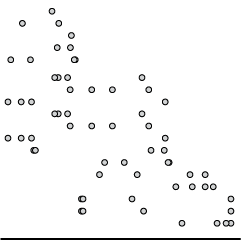Differences Between Women and Men’s Everyday with Kids
The day-to-day changes a lot when you have kids. Responsibilities change. You have a little person who is dependent on your choices. However, the everyday seems to change more for women than it does for men, as women tend to assume more of the new responsibilities in both frequency and time.
Using data from the American Time Use Survey, the chart below shows the percentage of mothers who said they did a child-care activity compared against fathers (on a non-holiday, weekday). Activities are sorted by the size of the percentage difference.
Who Takes Care of the Kids
A higher percentage of women parents take the responsibility for all activities.

MEN
WOMEN
Physical care
Picking up/dropping off
Homework
Talking with/listening to
Looking after (as a primary activity)
Waiting for/with
Reading to/with
Organization and planning
Obtaining medical care
Attending events
Providing medical care
Meetings and school conferences
Waiting for children’s health
Home schooling
Arts and crafts
Education, misc.
Playing sports
Caring for and helping, misc.
Playing, not sports
Waiting for children’s education
0%
20%
40%
60%
80%

MEN
WOMEN
Physical care
Picking up/dropoff
Homework
Talking with
Looking after
Waiting
Reading
Organization
Getting med. care
Events
Provide med. care
Meetings
Waiting for health
Home schooling
Arts and crafts
Education, misc.
Playing sports
Caring for, misc.
Playing, not sports
Waiting for edu.
0%
20%
40%
60%
This makes sense, right?
The above doesn’t answer my main curiosity though: Knowing that life changes after kids, how much does it change for men and women? The chart below shows the change in the percentage of people (vertical position) who did an activity and the change in median time spent (circle size and color), before and after kids. Orange is more. Green is less.
Differences After Kids for Men and Women
Circle size shows time difference with daily activity after kids. Position and color show percentage difference.
At the extremes, you see women working at a main job less and take care of kids more. For men, you see the changes, but they’re lower in magnitude.
Notes
Become a member. Support an independent site. Make great charts.
See What You GetFlowingData is made possible by supporting members. Since 2007, I, Nathan Yau, a real person, have been analyzing and visualizing data to help more people understand and appreciate it in their everyday lives.
If you liked this or want to make similar data things, please consider supporting this small corner of the internet. You get unlimited access to visualization courses, tutorials, and extra resources. Thanks. — Nathan



